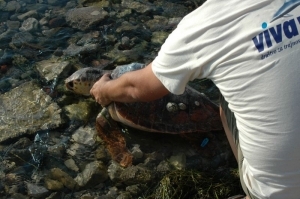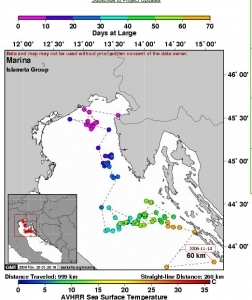Loggerhead sea turtles (Caretta caretta), Vivamar, and Adria Watch
For the first time in the Adriatic Sea,
we succeeded to learn more about the annual movement and travel of the loggerhead sea turtles (Caretta caretta) thanks to an Adria Watch project.
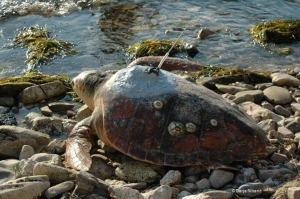
Slovenian loggerhead sea turtle (Caretta caretta) before heading back into the sea for a long journey… Vivamar, ©Darja Ribarič
Loggerhead sea turtles (Caretta caretta), Linnaeus, 1758, live in the Slovenian Sea and adjacent waters. They’re an important part of the marine ecosystem and like other large vertebrates, play a key role in the maintenance of its balance. Adria Watch launched an important project that involved tagging and releasing five loggerhead sea turtles that originated from three neighboring countries along the northern Adriatic Sea. The turtles used in the project were accidentally caught in fishing nets and rescued before drowning. A satellite transmitter was attached to the carapace, and animals were released back into their home marine environment along all coasts of the northern Adriatic: Slovenia, Italy and Croatia within a few days.
Satellite transmitters assist in monitoring the life history of animals, in this case loggerhead sea turtles in the Mediterranean Sea. Because so little research has been done on this population thus far, the method allows researchers to obtain valuable information about important marine areas for the loggerhead sea turtles in the Adriatic. This information can be used to facilitate a long term plan for sustainable management of the species and their ecosystems.
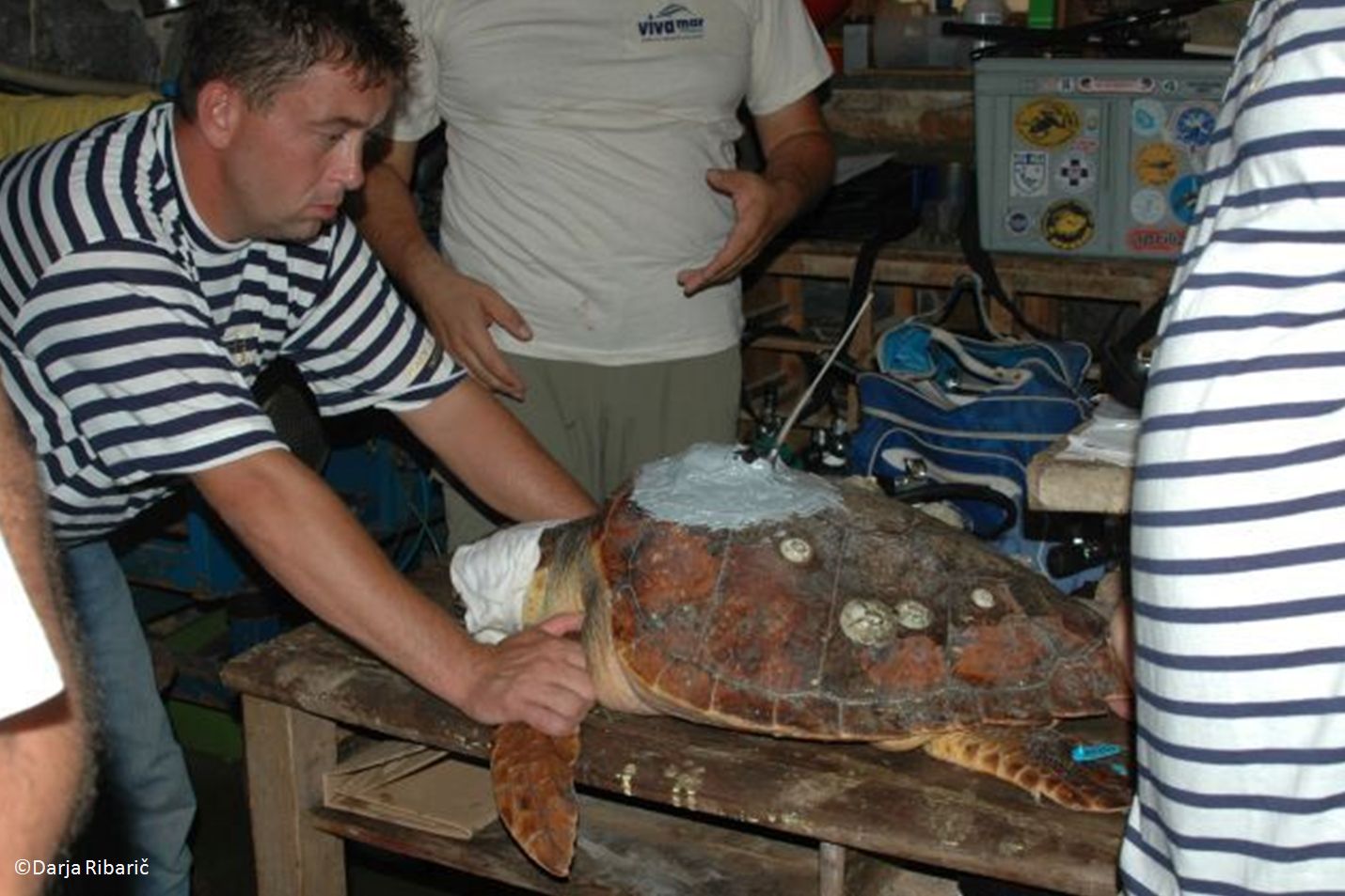
Mounting of a satellite transmitter: the sea turtles can be quite strong and their bites dangerous. They are firmly and safely restrained with their eyes covered throughout the process. Vivamar; ©Darja Ribarič
Adria Watch, Vivamar, and other partners contributed to the project to learn more. The goal is to track (for the first time!) how loggerhead sea turtles move in the Adriatic Sea or, as seen in one of the turtles, in the broader Mediterranean basin. We confirmed the importance of properly conserving and protecting these migrating animals by partnering up with neighboring countries whose waters the marine animals share— after all, a countries’ ocean boundary means nothing to a sea turtle who needs to travel to find food or a nesting site! Not only do these loggerhead sea turtles contribute to regulating the ecological status of the sea, but they are also a valuable natural heritage and protected species for a local and broader marine area.
This was demonstrated with each and every one of the sea turtles’ journeys in the Adria Watch project.
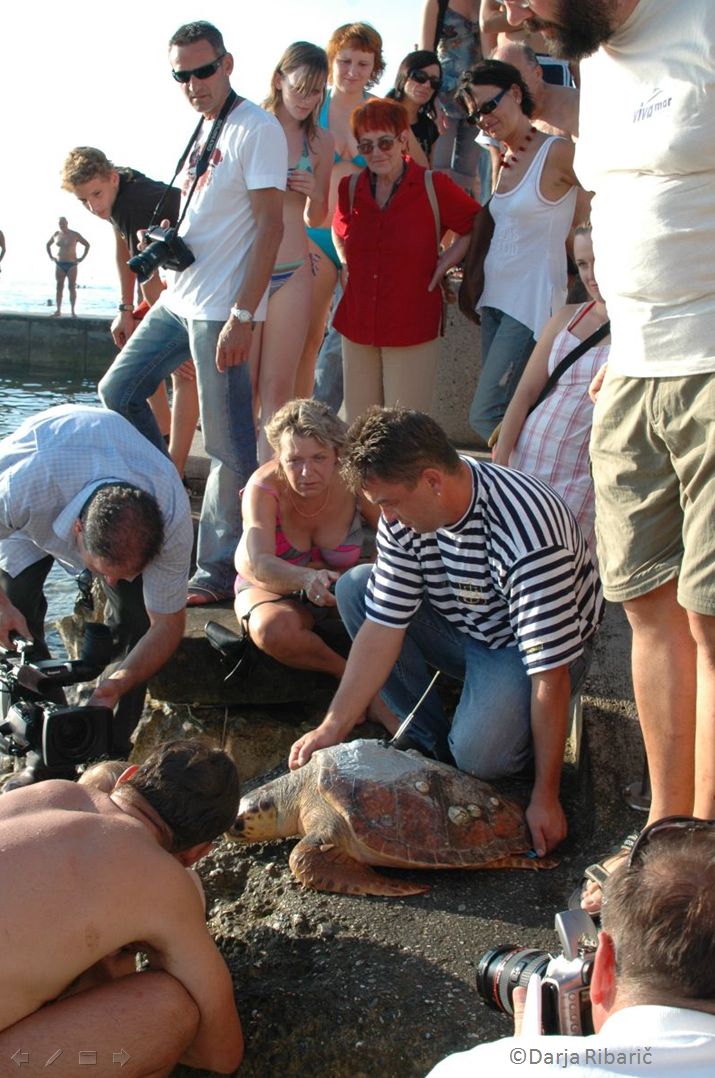
Piran, Slovenia: The release of Marina the sea turtle. This was a big attraction for locals as well as visitors! Vivamar, ©Darja Ribarič
One of the tagged sea turtles named Marina was entangled in a fishing net in the Slovenian sea. She was released back into the sea from Piran, Slovenia, where she swam across the Gulf of Trieste to the Italian side, stayed in the middle area for some days, and then traveled south along the west coast of Istria, Croatia. Eventually, she moved right to the middle of the Adriatic Sea and continued farther south to the Kornati Islands National Park.
During this trip Marina was in the middle of the Adriatic Sea, and Slovenian, Italian and Croatian waters. The second turtle was released from the island Lošinj in Croatia and others from the Italian coasts in the cities: Numana, Rimini and Trieste.
Another interesting travel adventure was made by the loggerhead Calypso, a juvenile who was released on the Italian side of the Adriatic. He traveled 2221 km from the coast of Venice, stayed most of the time in the middle of the Adriatic Sea and after eight months was located about 50 nautical miles west of the peninsula Pelješac, in the south Adriatic coast of Croatia.
Titania was the only adult loggerhead turtle in the project. This sea turtle was remarkable and traveled an incredible 7672km all together.
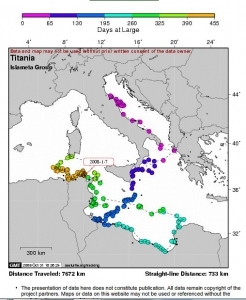
An amazing – almost 7700 km long journey of the adult loggerhead turtle Titania, in just a year and two months. Source: Adria Watch
Titania was monitored for one year and two months. If the distance traveled by Titania would be stretched out along the equator, the animal traveled almost 20% of the way around the world. This amazing swimmer was released off Rimini (Italy), swam along the Italian coast, left the Adriatic Sea and continued all the way past Sicily and Malta right to the North of Africa, Tunisia. From there it traveled eastwards along the Libyan coast and returned back to the shores off Tunis, then swam further along the coast of Algeria, where it stayed for some time. Then it swam across the middle of the Mediterranean Sea again all the way to the south coast of Sardinia and after that returned back to the coast off Tunisia. Impressive!
With the aid of Adria Watch’s project, our tagged loggerhead sea turtles have been shown to travel amazing distances in the Adriatic Sea and beyond (the majority of Titania’s time was spent in the Mediterranean Sea). These huge traveled distances reflect how important it is to maintain a healthy marine environment as a whole, no matter which country the territory belongs to. We have known for a while that loggerhead turtles found in the Adriatic Sea mostly have nesting sites on the Greek island Zakynthos, but probably also in the other parts of the Mediterranean Sea in regions such as Cyprus, Italy, Turkey and Israel. No doubt that they travel tremendous distances just to reach their nesting areas. Clearly, they are excellent swimmers, but it never hurts to catch a lift by exploiting the energy of the sea surface currents to help them overcome such impressive distances.
While it can be incredibly exciting to receive data about what these turtles are truly capable of, the feedback we get isn’t always the happiest. Two of our five tagged turtles, Jacopo and Valerio, were entangled in fishing nets again in just a short time. This information gives us some important questions: was this just an unfortunate event, or is it indicating a high rate of incidental by-catch of sea turtles in the Adriatic? Could this support the idea that because both were juveniles, they had little experience in avoiding the potential dangers from fishing nets? Jacopo was caught for the second time in a fishing net just 45 days after the first release, whereas Valerio after only 38 days. Unfortunately, the second time, they were not found alive. Overall, seven loggerhead sea turtles were tagged and monitored because Jacopo and Valerio’s transmitters were detached and mounted to two new turtles who had been accidentally caught as well.
Marina transmitted the signal for only 69 days. Neither she nor the transmitter was found; it could have been removed from the dead turtle by a fishermen and not reported. The fact that sea turtles Jacopo and Valerio were entangled in the fishing net for a second time in a short period can be a bad indicator for the species in the Adriatic Sea. The by-catch of juvenile individuals may be higher because they don’t travel the long distances that adults do, meaning that they may spend more time in areas that overlap with high amounts of fishing activity. Considering the fact that 2 out of our 5 turtles died, the next step is to determine the percentage of entangled turtles, and what percentage of those are rescued by fishermen on the spot. This project proves it is absolutely necessary to continue tagging turtles and collecting data about their distribution, as well as monitor turtle-fisherman interactions.

